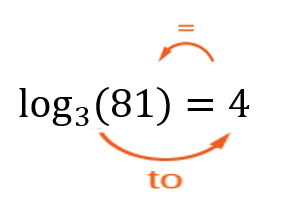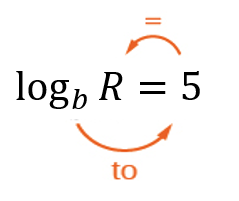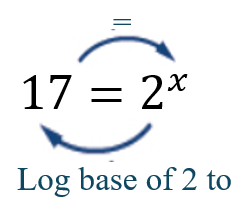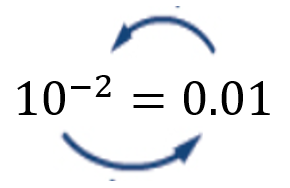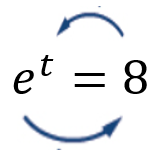3.4: Logarithmic Functions
Learning Objectives
- Determine the domain of a logarithmic function.
- Translate between logarithmic and exponential notation.
- Evaluate logarithmic expressions.
- Solve and graph logarithmic functions.
Logarithmic Functions
A Logarithmic function is considered the inverse function of an exponential function. That is,
If [latex]f\left(x\right)=b^x\left(x\in R\right)[/latex], then [latex]f^{-1}\left(x\right)=\log_bx\left(x>0\right),[/latex] where [latex]b>0,\;b\neq1[/latex].
If [latex]b>0,\;b\neq1[/latex], and [latex]x>0[/latex], then [latex]y=\log_b\left(x\right)[/latex] if an only if [latex]b^y=x[/latex].
We read it as “[latex]y[/latex] is the log base [latex]b[/latex] of [latex]x[/latex] ”, or “[latex]y[/latex] is the power we raise [latex]b[/latex] to get [latex]x[/latex]”
Since the logarithm is the inverse function of the exponential, thus the domain of the logarithm is the range of the exponential.
Determine the domain of a logarithmic function
Steps:
- Identify the variable:
- In the expression [latex]\log_bA[/latex] the variable is [latex]A[/latex].
- Set the argument of the log greater than 0:
- Since the argument of a logarithm must be positive, set: [latex]A>0[/latex]
- Solve for [latex]x[/latex]:
- Use algebra or logarithmic rules (if it’s an equation) to find the value of [latex]x[/latex] in the [latex]A[/latex] that satisfies the expression or equation.
Example 3.4-1-1: Find the domain of giving the logarithmic function.
[latex]f\left(x\right)=\log_5\left(x+2\right)[/latex]
 Key
Key
Example 3.4-1-1: Find the domain of giving the logarithmic function.
[latex]f\left(x\right)=\log_5\left(x+2\right)[/latex]
- Identify the variable:
In the expression [latex]\log_bA[/latex] the variable is [latex]A[/latex].

- Set the argument of the log greater than 0:
Since the argument of a logarithm must be positive, set: [latex]A>0[/latex]
[latex]x+2>0[/latex]
- Solve for [latex]x[/latex]:
Use algebra or logarithmic rules (if it’s an equation) to find the value of [latex]x[/latex] in the [latex]A[/latex] that satisfies the expression or equation.
[latex]x>-2[/latex]
Domain: [latex]\left(-2,\;\infty\right)[/latex]
 Your Turn
Your Turn
Practice 3.4-1-1
Translate between logarithmic and exponential notation
Logarithmic Function of Base [latex]b[/latex]
For [latex]x>0[/latex] and [latex]b>0,\;b\neq1,[/latex]
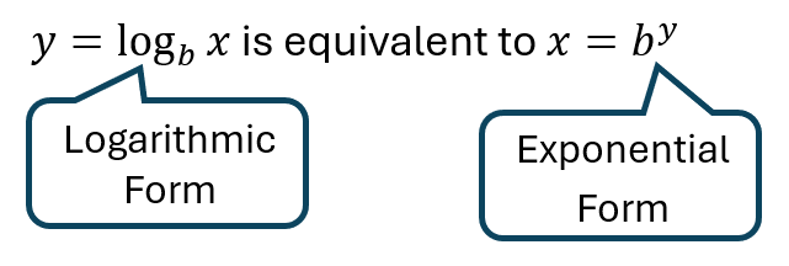
Arrow method:
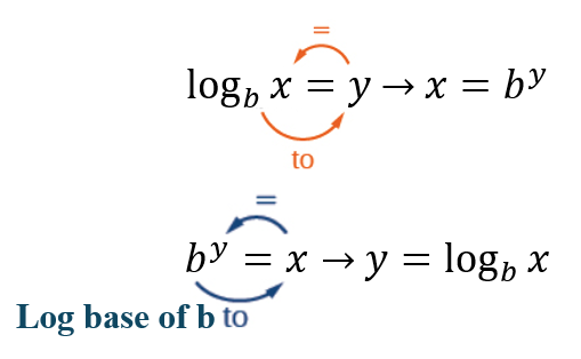
Note:
Common Logarithm [latex]\log_{10}\left(x\right)=\log\left(x\right)[/latex]
Natural Logarithm [latex]\log_e\left(x\right)=\ln\left(x\right)[/latex]
Example 3.4-2-1: Converting the following logarithmic equations to exponential equations.
- [latex]\log_3\left(81\right)=4[/latex]
- [latex]\log_bR=5[/latex]
- [latex]y=\log\;Q[/latex]
- [latex]\ln x=5[/latex]
 Key
Key
Example 3.4-2-1: Converting the following logarithmic equations to exponential equations.
|
|
[latex]3^4=81[/latex] |
|
|
[latex]b^5=R[/latex] |
- [latex]y=\log\;Q[/latex]
There is an invisible [latex]10[/latex] since it is a common logarithm; thus, we can rewrite it as
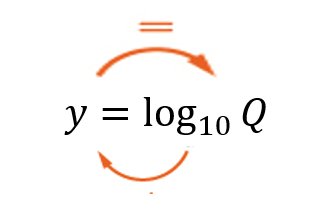
[latex]e^5=y[/latex]
Example 3.4-2-2: Converting the following exponential equations to logarithmic equations.
- [latex]17=2^x[/latex]
- [latex]10^{-2}=0.01[/latex]
- [latex]e^t=8[/latex]
 Key
Key
Example 3.4-2-2: Converting the following logarithmic equations to exponential equations.
[latex]x=\log_2\;17[/latex]
[latex]-2=\log_{10}\left(0.01\right)\rightarrow-2=\log\left(0.01\right)\;Common\;\log[/latex]
[latex]t=\log_e\left(8\right)\rightarrow t=\ln\left(8\right)\;Natural\;\log[/latex]
 Your Turn
Your Turn
Practice 3.4-2-1
Practice 3.4-2-2
Evaluate logarithmic expressions
Given a logarithm of the form [latex]y=\log_b\left(x\right)[/latex], evaluate it mentally.
- Rewrite the argument [latex]x[/latex] as a power of [latex]b\;:\;b^y=x[/latex].
- Use previous knowledge of powers of [latex]b[/latex] identify [latex]y[/latex] by asking, “To what exponent should [latex]b[/latex] be raised in order to get [latex]x[/latex]?”
Example 3.4-2-2: Solving Logarithms Mentally
Solve [latex]y=\log_4\left(64\right)[/latex] without using a calculator.
 Key
Key
Example 3.4-2-2: Solve [latex]y=\log_4\left(64\right)[/latex] without using a calculator.
First we rewrite the logarithm in exponential form: [latex]4^y=64[/latex]. Next, we ask, “To what exponent must [latex]4[/latex] be raised in order to get [latex]64[/latex]?”
We know
[latex]4^3=64[/latex]
Therefore,
[latex]\log_4\left(64\right)=3[/latex]
 Your Turn
Your Turn
Practice 3.4-3-1
Solve Simple Logarithms
For any logarithmic equation [latex]y=\log_bx\;or\;\log_bx=y[/latex], to find [latex]x[/latex],
- Translate to an exponential equation.
- Solve for [latex]x[/latex].
- Use the domain to check the answer, select the one that fits the domain [latex]\left(x>0\right)[/latex].
Example 3.4-4-1: Solve the logarithmic equation.
[latex]\log_3\left(8-x\right)=4[/latex]
 Key
Key
Example 3.4-4-1: Solve the logarithmic equation.
[latex]\log_3\left(8-x\right)=4[/latex]
- Translate to an exponential equation.
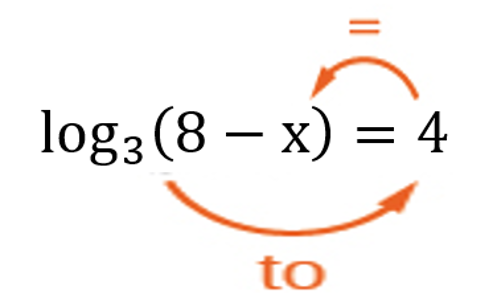
[latex]3^4=8-x[/latex]
- Solve for [latex]x[/latex].
[latex]3^4=8-x[/latex]
[latex]81=8-x[/latex]
[latex]81-8=-x[/latex]
[latex]73=-x[/latex]
[latex]-73=x[/latex]
[latex]x=-73[/latex]
- Use the domain to check the answer, select the one that fits the domain [latex]\left(x>0\right)[/latex].
Based on the domain rule, if [latex]\log_bA,\;A>0[/latex]
Thus, we need to ensure [latex]8-x>0[/latex]
Use [latex]x= - 73[/latex] substitute [latex]x[/latex] value,
[latex]8-\left(-7\right)=81[/latex], it is positive, which is greater than 0, thus the answer is
[latex]x=-73[/latex]

